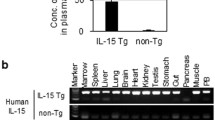Abstract
The transfer of human peripheral blood mononuclear cells (hu-PBMC) from adult Epstein-Barrvirus(EBV)-seropositive honors in SCID (severe combined immunodeficiency) mice frequently leads to the development of a human B lymphoproliferative syndrome (hu-BLPS). Therefore, as 90% of adult potential donors are EBV-seropositive, efforts have to be made to avoid the occurrence of this B lymphoproliferative disorder. McCune et al. [Science 241;1632 (1988)] used human fetal organs for a human SCID graft. This system does not give rise to hu-BLPS but human fetal organs are much less available than peripheral blood leucocytes. The experiments reported in this paper show how crucial is the presence offunctional T lymphocytes for a graft to take and for development of hu-BLPS in hu-PBMC-reconstituted SCID mice, since inhibition of T lymphocyte by a rat anti-(human CD2) monoclonal antibody (LO-CD2a) during the first 10 days of the graft prevents successful engraftment of human normal lymphocytes as well as hu-BLPS in SCID mice. The transfer of B cells alone or B cells plus monocytes in SCID mice does not permit either long-term engraftment or development of hu-BLPS. We also demonstrate that hu-PBMC treated withL-leucine methyl ester are less susceptible to the development of hu-BLPS after engraftment in SCID mice than are untreated hu-PBMC. The mechanism of action ofL-leucine methyl ester on these cells is discussed.
Similar content being viewed by others
References
Bazin H, Xhurdebise LM, Burtonboy G, Lebacq AM, De Clercq L, Cormont F (1984) Rat rat monoclonal antibodies. I. Rapid purification from in vitro culture supernatants. J Immunol Methods 66:261
Bazin H, Pear WS, Klein G, Sümeji J (1990) Rat immunocytomas (IR). In: Bazin H (ed) Rat hybridomas and rat monoclonal antibodies. CRC, Boca Raton, Fl, p 53
Berg LC, Copenhaver CM, Morrison VA, Gruber SA, Dunn DL, Gajl-Peczalska K, Strickler JG (1992) B-cell lymphoproliferative disorders in solid-organ transplant patients: detection of Epstein-Barr virus by in situ hybridization. Hum Pathol 23:159
Borrebaeck CAK (1988) Human mAbs produced by primary in vitro immunization. Immunol Today 9:355
Bosma GC, Custer RP, Bosma MJ (1983) A severe combined immunodeficiency mutation in the mouse. Nature 301:527
Bosma GC, Fried M, Custer RP, Carroll A, Gibson DM, Bosma MJ (1988) Evidence of functional lymphocyte in some (leaky) SCID mice. J Exp Med 167:1016
Bruggeman M, Spicer C, Buluwela L, Rosewell I, Barton S, Surani MA, Rabbitts TH (1991) Human antibody production in transgenic mice: expression from 100 kb human IgH locus. Eur J Immunol 21:1323
Carlsson R., Martesson C., Kalliomaki S., Ohlin M, Borrebaeck CAK (1992) Human peripheral blood lymphocytes transplanted into SCID mice constitute an in vivo culture system exhibiting several parameters found in a normal humoral immune response and are a source of immunocytes for the production of human monoclonal antibodies. J Immunology 148:1065
Dorshkind K, Keller GM, Philips RA, Miller RG, Bosma GC, O'Toole M, Bosma MJ (1984) Functional status of cells from lymphoïd and myeloïd tissues in mice with severe combined immunodeficiency disease. J Immunol 132:1804
Duhosal MA, Eming SA, Fischer P, Le turcq D, Barbas CF III, Thornton GB, Dixon FJ, Burton DR (1992) Immunization of Hu-PBL-Scid mice and the rescue of human monoclonal Fab fragments through combinatorial libraries. Nature 355:258
Hoffmann-Fezer G, Kranz B, Gall C, Thierfelder S (1992) Peritoneal sanctuary for human lymphopoiesis in SCID mice injected with human peripheral blood lymphocytes from Epstein-Barr virus-negative donors. Eur J Immunol 22:3161
Kamel-Reid S, Dick JE (1988) Engraftment of immunodeficient mice with human hematopoietic stem cells. Science 242:1706
Malynn BA, Blackwell JK, Fulop GM, Rathbun GA, Furley AJW, Ferrier P, Heinke LB, Philips RA, Yancopoulos GD, Alt FW (1988) The SCID defect affects the final step of the immunoglobulin VDJ recombinase mechanism. Cell 54:453
McCune JM, Namikawa R, Kaneshima H, Shultz LD, Lieberman M, Weissman IL (1988) The SCID-hu mouse: murine model for the analyses of human hematolymphoïd differentiation and function. Science 241:1632
McCune JM, Namikawa R, Shih C, Rabin L, Kaneshima H (1990) Suppression of HIV infection in AZT-treated SCID-hu mice. Science 247:564
Mosier DE, Gulizia RJ, Baird SM, Wilson DB (1988) Transfer of a functional human immune system to mice with severe combined immunodeficiency. Nature 335:256
Namikawa R, Weilbaecher KN, Kaneshima H, Yee EJ, McCune JM (1990) Long term human hematopoiesis in the SCID-hu mouse. J Exp Med 172:1055
Ohlin M, Danielsson L, Carlsson R, Borrebaeck CAK (1989) The effect of leucyl-leucine methyl ester on proliferation and Ig secretion of EBV-transformed human B lymphocyte. Immunology 66:485
Pflumio F, Lapidot T, Murdoch B, Patterson B, Dick JE (1993) Engraftment of human lymphoid cells into newborn Scid mice leads to graft-versus-host disease. Int Immunol 5:1509
Phillips RA, Jewett MAS, Gallie BL (1989) Growth of human tumors in immune-deficient SCID mice and nude mice. Curr Top Microbiol Immunol 152:259
Pisa P, Cannon MJ, Pisa EK, Cooper NR, Fow RI (1992) Epstein-Barr Barr virus induced lymphoproliferative tumours in severe combined immunodeficient mice are oligoclonal. Blood 79:173
Rudolphi A, Spiess S, Conradt P, Claesson MH, Reimann J (1991) CD3+T cells in severe combined immunodeficiency (SCID) mice. II. Transplantation of dm2 lymphoid cells into semi-allogeneic SCID mice. Eur J Immunol 21:1591
Veronese ML, Veronesi A, D'Andrea E, Mistro AD, Indraccolo S, Mazza MR, Mion M, Zamarchi R, Menin C, Panozzo M, Amadori A, Chieco-Bianchi L (1992) Lymphoproliferative disease in human peripheral blood mononuclear cell-injected SCID Mice. I. T lymphocyte requirement for B cell tumour generation. J Exp Med 176:1763
Wagner SD, Popov AV, Davies SL, Xian J, Neuberger MS, Brüggeman M (1994) The diversity of antigen-specific monoclonal antibodies from transgenic mice bearing human immunoglobulin gene miniloci. Eur J Immunol 24:2672
Author information
Authors and Affiliations
Rights and permissions
About this article
Cite this article
Bombil, F., Kints, J.P., Havaux, X. et al. A rat monoclonal anti-(human CD2) andL-leucine methyl ester impacts on human/SCID mouse graft and B lymphoproliferative syndrome. Cancer Immunol Immunother 40, 383–389 (1995). https://doi.org/10.1007/BF01525389
Received:
Accepted:
Issue Date:
DOI: https://doi.org/10.1007/BF01525389




